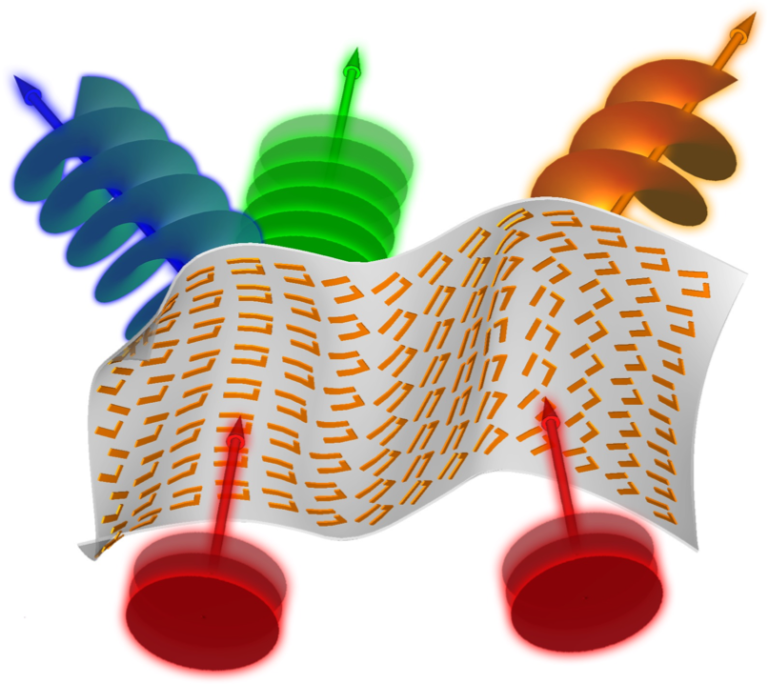Posted on August 14, 2018 in ASRC News, Photonics Initiative
The four-year program will support efforts to model and develop next-gen equipment to mold light and other electromagnetic waves.

NEW YORK, August 14, 2018 – Andrea Alù, director of the Photonics Initiative at the Advanced Science Research Center (ASRC) at The Graduate Center of The City University of New York and Einstein Professor of Physics at The Graduate Center, has received a Defense Advanced Research Projects Agency (DARPA) award of up to $3.2M to support basic nanophotonics research. The funded work will enable development of next-generation defense equipment based on engineered materials that manipulate electromagnetic waves, including light. Alù will lead a team of researchers from four institutions: the ASRC, The City College of New York, The University of Texas at Austin and École Polytechnique Fédérale de Lausanne.
During this four-year effort, the team will pursue an ambitious research agenda aimed at introducing and developing concepts for modeling, analyzing, designing and realizing leapfrog enhancements to electromagnetic-wave manipulation through the use of metamaterials. The final goal will be to open new avenues for developing vastly improved night-vision systems; integrated nonlinear signal isolators and infrared power limiters; efficient microwave-to-optical-photon conversion and counting; and on-chip devices with largely reduced noise.
“This research will enable us to push forward exciting new concepts that lay the ground for novel technologies that have extraordinary implications for society at large,” Alù said. “Our highly interdisciplinary team is made up of leading experts in theoretical, numerical and experimental aspects of electrical engineering, physics and nanophotonics. This is an ideal combination to put forward a new paradigm for enhancing light and matter interactions through the use of metamaterials.”
“The DARPA grant and the interdisciplinary team conducting this research are a realization of the vision we had for the kind of innovation that the ASRC would drive,” said Joshua Brumberg, dean for the sciences at The Graduate Center. “We’re very excited to see that Dr. Alù and his team are quickly and successfully bringing the kind of scientific research, resources and exciting opportunities to the ASRC and helping to raise the profile of the work being done here.”
DARPA’s Defense Science Office (DSO) supports high-risk, high-payoff research for future defense technologies. The DSO Nascent program is focused on developing models that describe and predict novel technology functionality based on a host of newly engineered metamaterials. The latter phases of the project seek to develop proven approaches by applying the models to new materials that are critical for advancing defense technologies.
***
Organizational Attribution
Our correct name is the Advanced Science Research Center at The Graduate Center of The City University of New York. For the purpose of space, Advanced Science Research Center, GC/CUNY is acceptable. On second reference, ASRC is correct.
About the Advanced Science Research Center
The ASRC at The Graduate Center elevates scientific research and education at CUNY and beyond through initiatives in five distinctive, but increasingly interconnected disciplines: environmental sciences, nanoscience, neuroscience, photonics, and structural biology. The ASRC promotes a collaborative, interdisciplinary research culture with renowned researchers from each of the initiatives working side by side in the ASRC’s core facilities, sharing equipment that is among the most advanced available.
About The Graduate Center of The City University of New York
The Graduate Center of The City University of New York (CUNY) is a leader in public graduate education devoted to enhancing the public good through pioneering research, serious learning, and reasoned debate. The Graduate Center offers ambitious students more than 40 doctoral and master’s programs of the highest caliber, taught by top faculty from throughout CUNY — the nation’s largest public urban university. Through its nearly 40 centers, institutes, and initiatives, including its Advanced Science Research Center (ASRC), The Graduate Center influences public policy and discourse and shapes innovation. The Graduate Center’s extensive public programs make it a home for culture and conversation.
###
